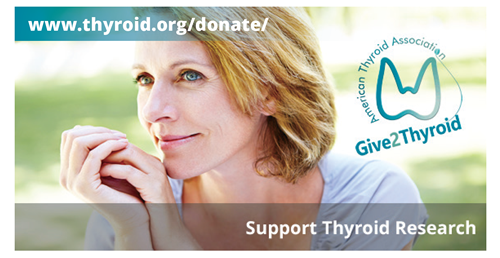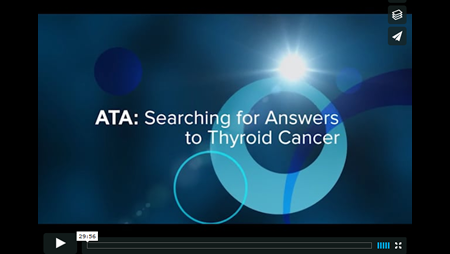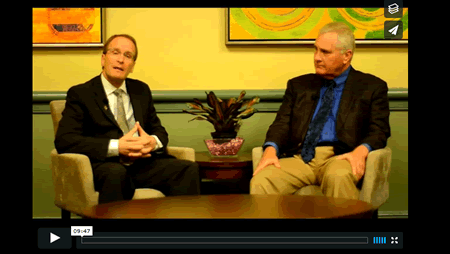Clinical Thyroidology for the Public summarizes selected research studies discussed in the previous month’s issue of Clinical Thyroidology, an official publication of the American Thyroid Association. Editor-in-chief, Alan Farwell, MD, FACE
Volume 12 Issue 12
Available in pdf format for saving and printing and Web page format for viewing online
PDF Format for Saving and Printing
Clinical Thyroidology for the Public Volume 12 Issue 12 (PDF file, 7.15 MB)
TABLE OF CONTENTS – Web Format
THYROID AND PREGNANCY Pregnancy is safe when it occurs at least 6 months after radioactive iodine treatment for thyroid cancer
In some cases of thyroid cancer, radioactive iodine therapy is needed after surgery to remove thyroid gland. Currently, the American Thyroid Association recommends women to wait at least 6 months to become pregnant after radioactive iodine therapy. This study was done to evaluate risk of abortion, premature birth, and birth defect after radioactive iodine therapy for thyroid cancer.
Kim HO et al. 2019 Association Between Pregnancy Outcomes and Radioactive Iodine Treatment After Thyroidectomy Among Women With Thyroid Cancer. JAMA Int Med. Epub 2019 Oct 21. PMID: 31633736
(PDF File for saving and printing, 482 KB)
THYROID AND PREGNANCY Risk of birth defects in babies from mothers with hyperthyroidism treated with Methimazole or Propylthiouracil
MMI and PTU are the main antithyroid drugs for the treatment of hyperthyroidism. MMI is preferred in non-pregnant patients because PTU can rarely cause liver problems, but is less preferred in pregnancy due to an increased risk of birth defects. The 2017 ATA Guidelines recommends PTU for the treatment of hyperthyroidism in early pregnancy then switching it MMI in the 2nd trimester. This study was performed in order to evaluate these recommendations.
Andersen SL et al (2019) Maternal thyroid function, use of antithyroid drugs in early pregnancy and birth defects. J Clin Endocrinology Epub 2019 Aug 13. PMID: 31408173
(PDF File for saving and printing, 302 KB)
THYROID AND PREGNANCY Initiation of levothyroxine therapy for subclinical hypothyroidism during pregnancy in the United States.
During pregnancy, some, but not all, studies show that treating subclinical hypothyroidism in pregnancy may reduce the risk of miscarriage. As a result, some clinical practice guidelines recommend treating subclinical hypothyroidism with levothyroxine, although there is still no definitive agreement among all the professional societies. The current study examines the prescribing practices for pregnant women with subclinical hypothyroidism to determine the factors that influence who is and who is not given levothyroxine for subclinical hypothyroidism during pregnancy.
Maraka S et al Variation in treatment practices for subclinical hypothyroidism in pregnancy: US national assessment. 2019 J Clin Endocrinol Metab, Epub 2019 Apr 24
(PDF File for saving and printing, 586 KB)
THYROID CANCER Successful chemotherapy is possible for seemingly inoperable anaplastic thyroid cancer
While the vast majority of thyroid cancers are slow growing and have an excellent prognosis, anaplastic thyroid cancer, which makes up <1% of all thyroid cancer, is one of the most aggressive of all cancers, with a survival averaging ~6 months after diagnosis. Surgery, radiation and single drug chemotherapy is all ineffective in most cases. The aim of this study is to study if combination chemotherapy will make previously inoperable anaplastic thyroid cancers safe to remove with surgery.
Wang JR et al 2019 Complete surgical resection following neoadjuvant dabrafenib plus trametinib in BRAFV600Emutated anaplastic thyroid carcinoma. Thyroid 29:1036– 1043. PMID: 31319771.
(PDF File for saving and printing, 418 KB)
THYROID NODULES Volume doubling time does not predict cancer in follicular neoplasm nodules
Up to 15% of biopsied of thyroid nodules nodules are reported as indeterminate, with up to 25% of these reported as follicular neoplasms. Although less than half of follicular neoplasms are cancer, many patients undergo surgery for a definitive diagnosis. The goal of this study was to evaluate whether the growth rate of thyroid nodules with follicular neoplasm cytology can predict the presence of cancer.
Kim M et al 2019 Determining whether tumor volume doubling time and growth rate can predict malignancy after delayed diagnostic surgery of follicular neoplasm. Thyroid. 2019 Oct;29(10):1418-1424 Epub Sep 5. PMID: 31375058.
(PDF File for saving and printing, 311 KB)
THYROID SURGERY Narcotics are not needed after thyroid surgery
Physicians contribute to the opioid epidemic by prescribing opioids after most surgical procedures. Thyroid and parathyroid surgery are generally well-tolerated procedures and many endocrine surgeons are already not prescribing narcotics. In this study, the authors counseled patients on possible opioid use before surgery and then let the patients decided if they needed it.
Ruffolo LI et al2019 Narcotic free cervical endocrine surgery: a shift in paradigm. Ann Surg. Epub 2019 July 6. PMID: 31356280.
(PDF File for saving and printing, 295 KB)









